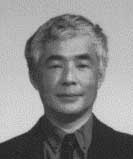
Japanese local cities have been suffering from the decline of the central business and commercial areas. This is due partly to universal motorization and partry to the city's inability to rebuild its central areas. Many cities have built road networks that enable city residents to move out to the suburban areas and commercial facilities to choose their locations in the suburbs where the main mode of transportation is automobile. This has resulted in the decline in the use of public transportation.
Kanazawa is not an exception with the central areas losing population and the business and commercial zones stagnating activities. Compared to many other major local cities, however, Kanazawa is in a much better position as its historical districts still attract many tourists and many public faculties are located in the proximity of the central areas.
Kanazawa is not a model city from the modern city planning point of view as it could not build as many planned roads nor rebuilt its central areas as much as other local cities. However, with its rich historical heritages and local cultures and traditions, Kanazawa has managed to be a lively city and maintained its status as the center of Hokuriku Region.
Hokuriku Region, situated on the Japan Sea side of Honshu, has long been a remote and isolated land despite its relatively close location to the three major metropolises. Now, at the turn of the century, the Region faces the time of change as the National Freeway Network is almost complete and the Shinkansen Network appears to be coming to the region.
Kanazawa City has announced its Master Plan last year to provide for the 21st century. While preparing for the age of regional competition, the city tries to enhance its character of the historical city, to promote the shopping streets, and to create new attractions in the inner city.
Kanazawa may be an exceptional case but it should become one of the front runners in the nationwide movement to revitalize central areas taking advantage of its own characteristics. This issue of CPIJ Newsletter covers the topic of inner city revitalization taking Kanazawa City as a case study.
Although Kanazawa is a city with rich historical heritages, its image as a "Historical Capital" is not appropriate. Kanazawa started its history when Oyama-gobou Fort was built by Buddhist Rebels in 1546 and became the center of the region. This was Japan's Warring States Period when regional lords were fighting with each other for supremacy and thus built castle cities that would later become regional centers. As Kanazawa was founded in the same period, it is a city of the average age, not of the especially old age. It is because Kanazawa has developed in a quite different process from most other local cities that the city is often mistaken as a "Historical Capital."
Kanazawa started the first phase of its own development process after the Meiji Restoration when centralization of power was progressed and the European system, policies and technologies were imported. Most citied tried to transform themselves to bear their share in pursuing the national goals by promoting capitalization and industrialization as well as by strengthening transportation functions. They have become specialized cities, from regional centers of the previous period with a balance of all functions. On the contrary, Kanazawa had progressed its modernization process at its own pace though its population ranking has dropped constantly from the fourth in the nation.
The second phase came with WWII when Japan, with its success in modernization, fought against the then advanced countries and lost miserably. All of 120 Japanese cities that had suffered from war damages were those with important industrial or transportation functions. Kanazawa, together with Kyoto, Nara and Kurashiki, was said to be excluded from the bombing targets on the ground that they preserved Japanese traditions. This implied that preservation, not modernization, was the best defense strategy.
The third phase was the postwar period when cities tried to implement modern city planning, to make them fireproof, to adjust to motorization, and to realize the international design standard. The effort that Japanese people made was remarkable in making Japan an economic power and transforming war-damaged cities into modern urban centers. Kanazawa, on the other hand, took a different process of development. The people of Kanazawa were first pleased to have survived war destructions but soon became envious of other cities and even felt unlucky to be leftout from bombing targets as damaged cities renewed the station-front areas, strengthened the business and commercial zones, and built new housing and parks.
In sum, keeping their development strategy always independent of the national goals, Kanazawa has maintained characters of Edo, Meiji and other periods within its urban areas. This type of strategy is often seen in the European countries but unique in Japan.
Now that Japan has become one of the wealthiest nations and individual characters of cities such as natural, historical, cultural and social features are vital in making cities desirable place to live. In that sense Kanazawa is considered truly luckily to have survived war damages. If Kanazawa hopes to further develop its urban functions, however, traditional elements will be wiped out and its intrinsic characters destroyed, because the city has the central areas filled with historical heritages. This means that, in order to absorb new urban functions the city needs to build subcenters tied closely to the existing center by strong transportation corridors. With this new urban structure Kanazawa will certainly become the city with both traditional and modern elements coexisting in harmony.
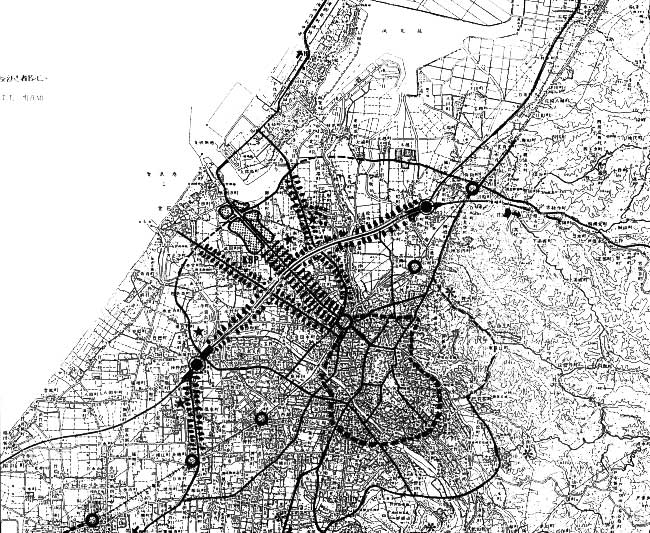
Atsuo Tsuchiba
Professor, the University of Shiga Prefecture
1. Construction Process of Kanazawa
Kanazawa has a long history of 400 years as a castle city and 450 years since its foundation. The city was originally built as a temple town on the heights of Kodatsuno and became the castle city of Load Sakuma in 1580 and then of the city was enlarged several times as the territories of Lord Maeda expanded. The city completed its original road structure by the redevelopment of the central areas after the extensive fire in the 1630's. In the 1660's the city expanded further outwards.
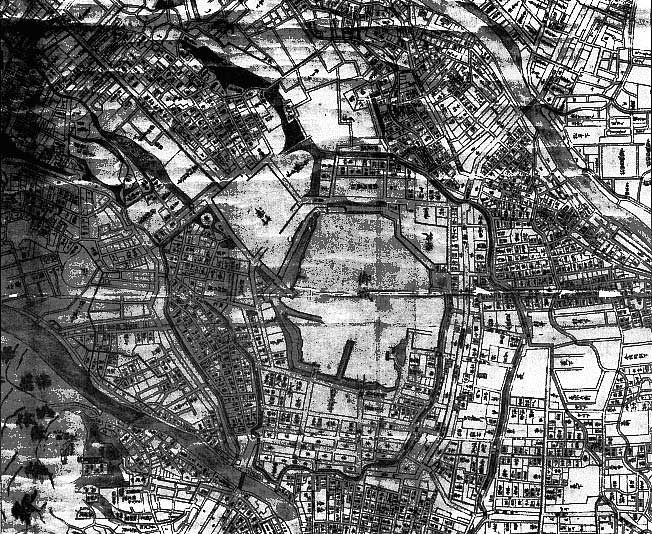
The city has a complex structure due not only to its complicated geographical features but also to its unplanned expansion process during the Edo Era. As the result of long and step-by-step expansion, Kanazawa's urban areas have a structure of circular roads around the castle and redial roads starting from them. This old urban areas of Kanazawa did not expand until the 1920's of the Taisho Era because the city became stagnant. Within the old urban areas Chonin (merchants and craftsmen) lived in Machiya (townhouses with a store space on the front side) facing the street, making the street a lively space. Whereas Samurai (warriors) lived in a single house with a large lot surrounded by mud walls.
While many Japanese cities have changed their faces completely by the restoration from war damages and big fires, Kanazawa has escaped from these major destructions since the mid 18th century and managed to maintain its old urban areas. This makes Kanazawa an attractive place to stroll around. As you walk from one street to the other the look of the city changes dramatically. For example, you can see a series of different townscape from a modern skyscrapers along the main street to a back street of a calm tree-covered Samurai district and then to a Chonin district as you walk along a channel.
2. Historical Preservation in Kanazawa
In 1968 Kanazawa enacted "Traditional Environment Preservation Ordinance" to protect its historical environment. This was the very first of its kind on the local level and aimed at protecting living environment, but not historical townscape, in the urban and suburban areas. However, as many of the important historical districts such as the famous Nagamachi Samurai district and Temple Town were included in the designated areas, restoration of mud walls and temple gates were proceeded gradually.
In 1976, Higashiyama Teahouse District was under consideration to be a "Traditional Buildings Preservation District" under a townscape preservation program on the national level. This effort was not successful because of the opposition by residents leaving Kanazawa's townscape preservation delayed for same years. In 1982, however, the designated areas of "Traditional Environment Preservation Ordinance" were expanded to the area including Kazue-machi where traditional Machiya-style teahouses were preserved. This has led to the preservation of three teahouse districts of Kanazawa (Higashiyama, Nishi and Kazue-machi). Also, as the area along the rivers were already built-up by high-rise buildings, it was necessary to implement detailed height restriction.
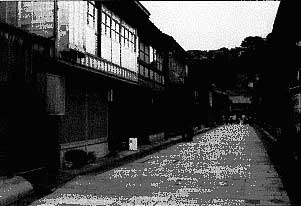
After the 1980's citizens of Kanazawa have become well aware of the importance of historic preservation and reached a consensus that Kanazawa's characters can be best identified when its townscape and traditional cultures are preserved. They something objected to the demolition of historical buildings.
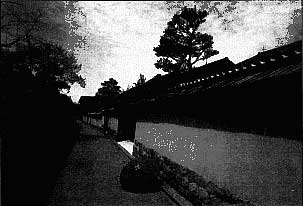
In 1989, the city developed its original "Traditional Environment Preservation Ordinance" into the "Urban Landscape Ordinance" that has enable the city to preserve historic districts as well as to create modern urban landscape in its CBD. The Ordinance implemented more detailed height restrictions than its predecessor had done.
In 1994, the city enacted the "Komachinami (small-scale townscape) Preservation Ordinance" to protect small-scale historical districts scattered in the central areas. Two Samurai districts and four Chonin districts have been designated by 1998 and preservation efforts have begun.